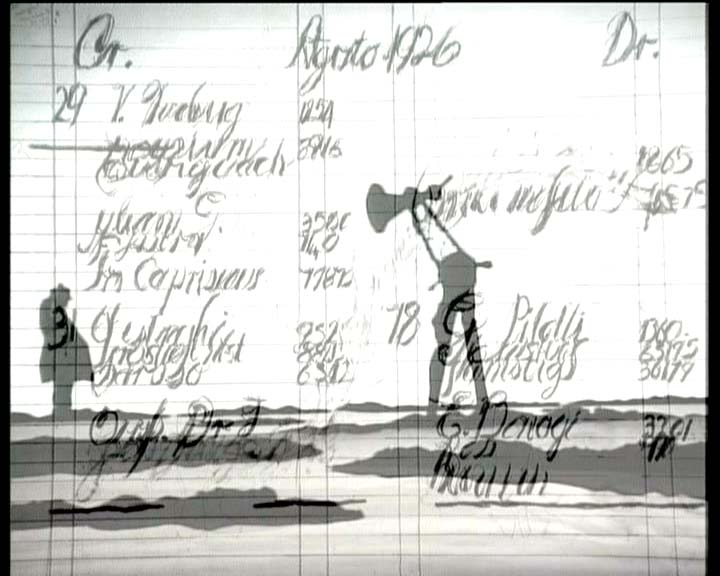We acknowledge the Traditional Owners of the land on which the Queensland Art Gallery | Gallery of Modern Art stands and recognise the creative contribution First Australians make to the art and culture of this country.

William Kentridge / South Africa b.1955 / Zeno writing (still) 2002 / Betacam SP transferred to DVD, black and white, stereo, 11:00 minutes, ed. 5/8 / The James C. Sourris AM Collection / Purchased 2004 with funds from James C. Sourris through and with the assistance of the Queensland Art Gallery Foundation / Collection: Queensland Art Gallery | Gallery of Modern Art / © William Kentridge
William KentridgeZeno writing 2002
Not Currently on Display
Zeno writing 2002 is based on Italo Svevo’s 1923 novel Confessions of Zeno, and contrasts the atmosphere of post-World War One Trieste with contemporary Johannesburg. The film was premiered in Europe at ‘Documenta XI’ as a component of a multimedia theatre performance to great acclaim. Zeno is a guilt-ridden figure who is in psychoanalysis, and the film follows his anxieties and outlines his particular social context. It also points to parallels with contemporary dilemmas. Artist William Kentridge remarks:
‘Zeno, the hero of Svevo’s novel, has remarkable self-knowledge. But it is a knowledge without effect. The absolute inability of self-knowledge to force Zeno to act, or, at other times, to stop him from acting, feels familiar. People stuck at the edge of a historical project about to implode, stuck waiting for the eruption to happen. The teasing out of an ambiguous sense of place, and the convoluted relation we have to our own sense of self, form the starting point for the work.’1
Kentridge’s unique palette of hand-drawn and filmic elements is deftly illustrated in Zeno writing. The alterations and tracery of erased marks are activated through the animation process to seamlessly evoke a black and white drama of personal obsession and a landscape of displaced humanity — a now familiar trope of twentieth-century history. It is a work of powerful emotional intensity which embraces and confronts the theme of the individual’s personal dilemma within a wider anarchic context of indifferent, historical destiny.
Endnotes:
1. Press release, ‘William Kentridge: Zeno writing’, Marian Goodman Gallery, New York, 2002.
William Kentridge was born in 1955 in Johannesburg, South Africa. He attended the Johannesburg Art Foundation from 1976 to 1978 and became a teacher of etching there in 1978. Since the mid 1970s William Kentridge has worked as an actor, set designer and director of theatre and operas. Kentridge’s practice embraces a number of disciplines including printmaking and drawing. Film has become an increasingly important aspect of Kentridge’s work since the late 1980s. His unique and thoroughly non-digital method of making animated films from charcoal drawings which are progressively erased, filmed and reworked is referred to by the artist as ‘drawings for projection’.
Kentridge’s work is informed by the political and historical realities of his homeland in South Africa, although he transcends local interest to address the human condition. Issues of concern include personal and civil strife, social inequity, and the interrelation of identity, memory, guilt and forgiveness. These subjects are played out against the background of a decimated landscape combining violence and fantasy.